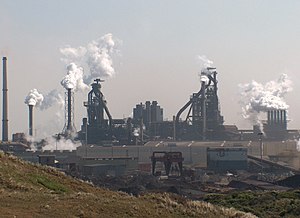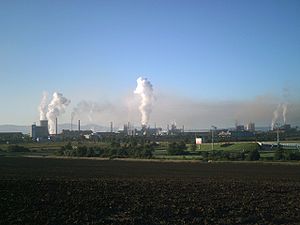Heavy industry


Heavy industry is an industry that involves one or more characteristics such as large and heavy products; large and heavy equipment and facilities (such as heavy equipment, large machine tools, huge buildings and large-scale infrastructure); or complex or numerous processes. Because of those factors, heavy industry involves higher capital intensity than light industry does, and it is also often more heavily cyclical in investment and employment.
Types[]
Transportation and construction along with their upstream manufacturing supply businesses have been the bulk of heavy industry throughout the industrial age, along with some capital-intensive manufacturing. Traditional examples from the mid-19th century through the early 20th included steelmaking, artillery production, locomotive manufacturing, machine tool building, and the heavier types of mining. From the late 19th century through the mid-20th, as the chemical industry and electrical industry developed, they involved components of both heavy industry and light industry, which was soon also true for the automotive industry and the aircraft industry. Modern shipbuilding (since steel replaced wood) and large components such as ship turbochargers are also characteristic of heavy industry.[1] Large systems are often characteristic of heavy industry such as the construction of skyscrapers and large dams during the post–World War II era, and the manufacture/deployment of large rockets and giant wind turbines through the 21st century.[2]
As part of economic strategy[]
Many East Asian countries relied on heavy industry as key parts of their development strategies[3] and many still do for economic growth.[4] This reliance on heavy industry is typically a matter of government economic policy. Among Japanese and Korean firms with "heavy industry" in their names, many are also manufacturers of aerospace products and defense contractors to their respective countries' governments such as Japan's Mitsubishi Heavy Industries and Fuji Heavy Industries, and Korea's Hyundai Rotem, a joint project of Hyundai Heavy Industries and Daewoo Heavy Industries.[5]
In 20th-century communist states, the planning of the economy often focused on heavy industry as an area for large investments, even to the extent of painful opportunity costs on the production–possibility frontier (classically, "lots of guns and not enough butter"). This was motivated by fears of failing to maintain military parity with foreign capitalist powers. For example, the Soviet Union's industrialization in the 1930s, with heavy industry as the favored emphasis, sought to bring its ability to produce trucks, tanks, artillery, aircraft, and warships up to a level that would make the country a great power. China under Mao Zedong pursued a similar strategy, eventually culminating in the Great Leap Forward of 1958–1960, an attempt to rapidly industrialize and collectivize.[6][7]
In zoning[]
Heavy industry is also sometimes a special designation in local zoning laws, allowing placement of industries with heavy impacts (on environment, infrastructure, and employment) with planning. For example, the zoning restrictions for landfills usually take into account the heavy truck traffic that will exert expensive wear on the roads leading to the landfill.[8]
Greenhouse gas emissions[]
This section needs expansion. You can help by . (August 2021) |
As of 2019 heavy industry emits about 22% of global greenhouse gas emissions: high temperature heat for heavy industry being about 10% of global emissions.[9] The steel industry alone was responsible for 7 to 9 % of the global carbon dioxide emissions which is inherently related to the main production process via reduction of iron with coal.[10] In order to reduce these carbon dioxide emissions, carbon capture and utilization and carbon capture and storage technology is looked at. Heavy industry has the advantage to be a point source which is less energy-intensive to apply the latter technologies and results in a cheaper carbon capture compared to direct air capture.
Pollution effects[]
This section needs expansion. You can help by . (August 2021) |
Heavy metals such as lead, chromium, cadmium, and arsenic form dustfall particles and are harmful to the human body, with the latter two being carcinogens.[11] Long-term or short-term exposure of children to industry-based air pollution can cause several adverse effects, such as cardiovascular diseases, respiratory diseases and even death. Children are also more susceptible to air pollution detriments than adults.[12] Heavy metals have also been shown to pollute soil, deteriorating arable land quality and adversely impacting food safety (such as vegetables or grain).[13]
References[]
- ^ https://www.mhi.com/expertise/showcase/column_0019.html
- ^ Teubal, Morris (1973). "Heavy and Light Industry in Economic Development". The American Economic Review. 63 (4): 588–596. ISSN 0002-8282.
- ^ Park, Jong H. "The East Asian Model of Economic Development and Developing Countries." Journal of Developing Societies 18.4 (2002): 330-53. Print.
- ^ Kumar, N. (2020). EAST ASIA’S PATHS TO INDUSTRIALIZATION AND PROSPERITY: LESSONS FOR INDIA AND OTHER LATE COMERS IN SOUTH ASIA.
- ^ Wade, Robert (2003-11-30). Governing the Market: Economic Theory and the Role of Government in East Asian Industrialization (With a New introduction by the author ed.). Princeton, NJ: Princeton University Press. ISBN 978-0-691-11729-4.
- ^ Walder, Andrew G. (2015-04-06). "5, 8". China Under Mao. Harvard University Press. ISBN 978-0-674-28670-2.
- ^ Naughton, Barry J. (2006-10-27). The Chinese Economy: Transitions and Growth. Cambridge, Mass: The MIT Press. ISBN 978-0-262-64064-0.
- ^ Committee, British Association Glossary (1952). "Some Definitions in the Vocabulary of Geography, IV". The Geographical Journal. 118 (3): 345–346. doi:10.2307/1790321. ISSN 0016-7398. JSTOR 1790321.
- ^ Roberts, David (2019-10-10). "This climate problem is bigger than cars and much harder to solve". Vox. Retrieved 2019-10-20.
- ^ De Ras, Kevin; Van De Vijver, Ruben; Galvita, Vladimir V.; Marin, Guy B.; Van Geem, Kevin M. (2019-12-01). "Carbon capture and utilization in the steel industry: challenges and opportunities for chemical engineering". Current Opinion in Chemical Engineering. 26: 81–87. doi:10.1016/j.coche.2019.09.001. ISSN 2211-3398.
- ^ Wang, J., Zhang, X., Yang, Q., Zhang, K., Zheng, Y., & Zhou, G. (2018). Pollution characteristics of atmospheric dustfall and heavy metals in a typical inland heavy industry city in China. Journal of Environmental Sciences, 71, 283-291.
- ^ Bergstra, A.D., Brunekreef, B. & Burdorf, A. The effect of industry-related air pollution on lung function and respiratory symptoms in school children. Environ Health 17, 30 (2018). https://doi.org/10.1186/s12940-018-0373-2
- ^ Impact of Soil Heavy Metal Pollution on Food Safety in China Zhang X, Zhong T, Liu L, Ouyang X (2015) Impact of Soil Heavy Metal Pollution on Food Safety in China. PLOS ONE 10(8): e0135182. https://doi.org/10.1371/journal.pone.0135182
External links[]
| Look up heavy industry in Wiktionary, the free dictionary. |
- Heavy industry
- Industries (economics)